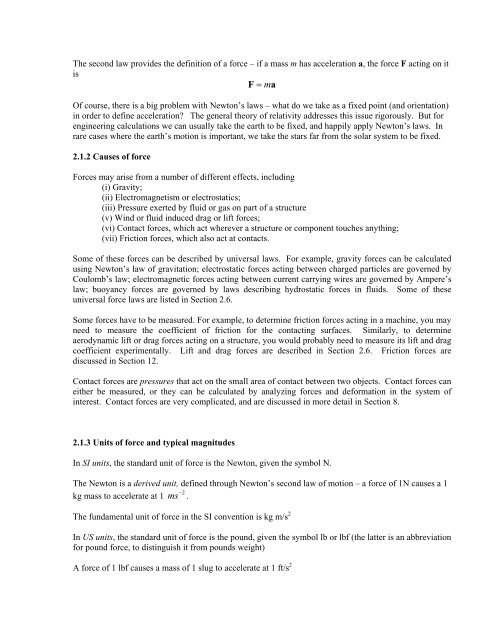Chapter 2 Review of Forces and Moments - Brown University
Chapter 2 Review of Forces and Moments - Brown University
Chapter 2 Review of Forces and Moments - Brown University
Create successful ePaper yourself
Turn your PDF publications into a flip-book with our unique Google optimized e-Paper software.
The second law provides the definition <strong>of</strong> a force – if a mass m has acceleration a, the force F acting on it<br />
is<br />
F = ma<br />
Of course, there is a big problem with Newton’s laws – what do we take as a fixed point (<strong>and</strong> orientation)<br />
in order to define acceleration? The general theory <strong>of</strong> relativity addresses this issue rigorously. But for<br />
engineering calculations we can usually take the earth to be fixed, <strong>and</strong> happily apply Newton’s laws. In<br />
rare cases where the earth’s motion is important, we take the stars far from the solar system to be fixed.<br />
2.1.2 Causes <strong>of</strong> force<br />
<strong>Forces</strong> may arise from a number <strong>of</strong> different effects, including<br />
(i) Gravity;<br />
(ii) Electromagnetism or electrostatics;<br />
(iii) Pressure exerted by fluid or gas on part <strong>of</strong> a structure<br />
(v) Wind or fluid induced drag or lift forces;<br />
(vi) Contact forces, which act wherever a structure or component touches anything;<br />
(vii) Friction forces, which also act at contacts.<br />
Some <strong>of</strong> these forces can be described by universal laws. For example, gravity forces can be calculated<br />
using Newton’s law <strong>of</strong> gravitation; electrostatic forces acting between charged particles are governed by<br />
Coulomb’s law; electromagnetic forces acting between current carrying wires are governed by Ampere’s<br />
law; buoyancy forces are governed by laws describing hydrostatic forces in fluids. Some <strong>of</strong> these<br />
universal force laws are listed in Section 2.6.<br />
Some forces have to be measured. For example, to determine friction forces acting in a machine, you may<br />
need to measure the coefficient <strong>of</strong> friction for the contacting surfaces. Similarly, to determine<br />
aerodynamic lift or drag forces acting on a structure, you would probably need to measure its lift <strong>and</strong> drag<br />
coefficient experimentally. Lift <strong>and</strong> drag forces are described in Section 2.6. Friction forces are<br />
discussed in Section 12.<br />
Contact forces are pressures that act on the small area <strong>of</strong> contact between two objects. Contact forces can<br />
either be measured, or they can be calculated by analyzing forces <strong>and</strong> deformation in the system <strong>of</strong><br />
interest. Contact forces are very complicated, <strong>and</strong> are discussed in more detail in Section 8.<br />
2.1.3 Units <strong>of</strong> force <strong>and</strong> typical magnitudes<br />
In SI units, the st<strong>and</strong>ard unit <strong>of</strong> force is the Newton, given the symbol N.<br />
The Newton is a derived unit, defined through Newton’s second law <strong>of</strong> motion – a force <strong>of</strong> 1N causes a 1<br />
2<br />
kg mass to accelerate at 1 ms − .<br />
The fundamental unit <strong>of</strong> force in the SI convention is kg m/s 2<br />
In US units, the st<strong>and</strong>ard unit <strong>of</strong> force is the pound, given the symbol lb or lbf (the latter is an abbreviation<br />
for pound force, to distinguish it from pounds weight)<br />
A force <strong>of</strong> 1 lbf causes a mass <strong>of</strong> 1 slug to accelerate at 1 ft/s 2
















